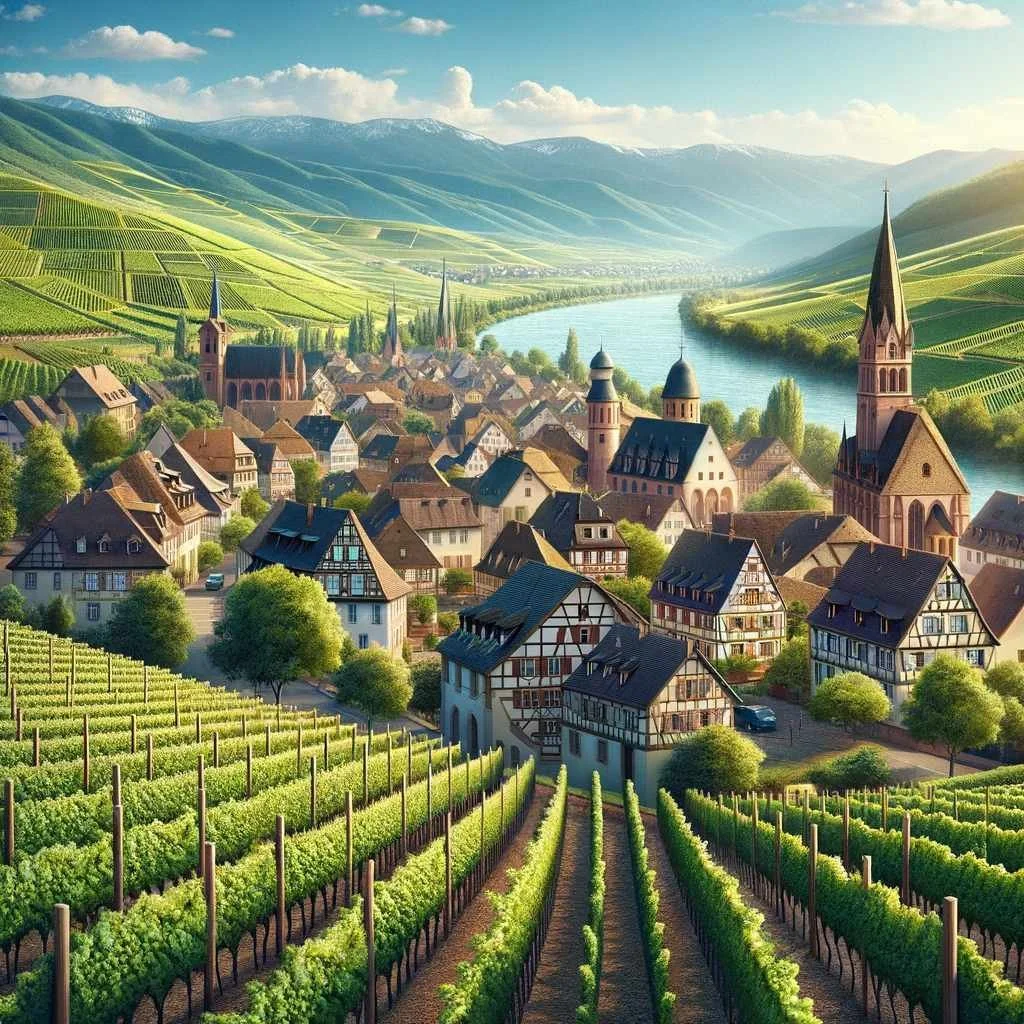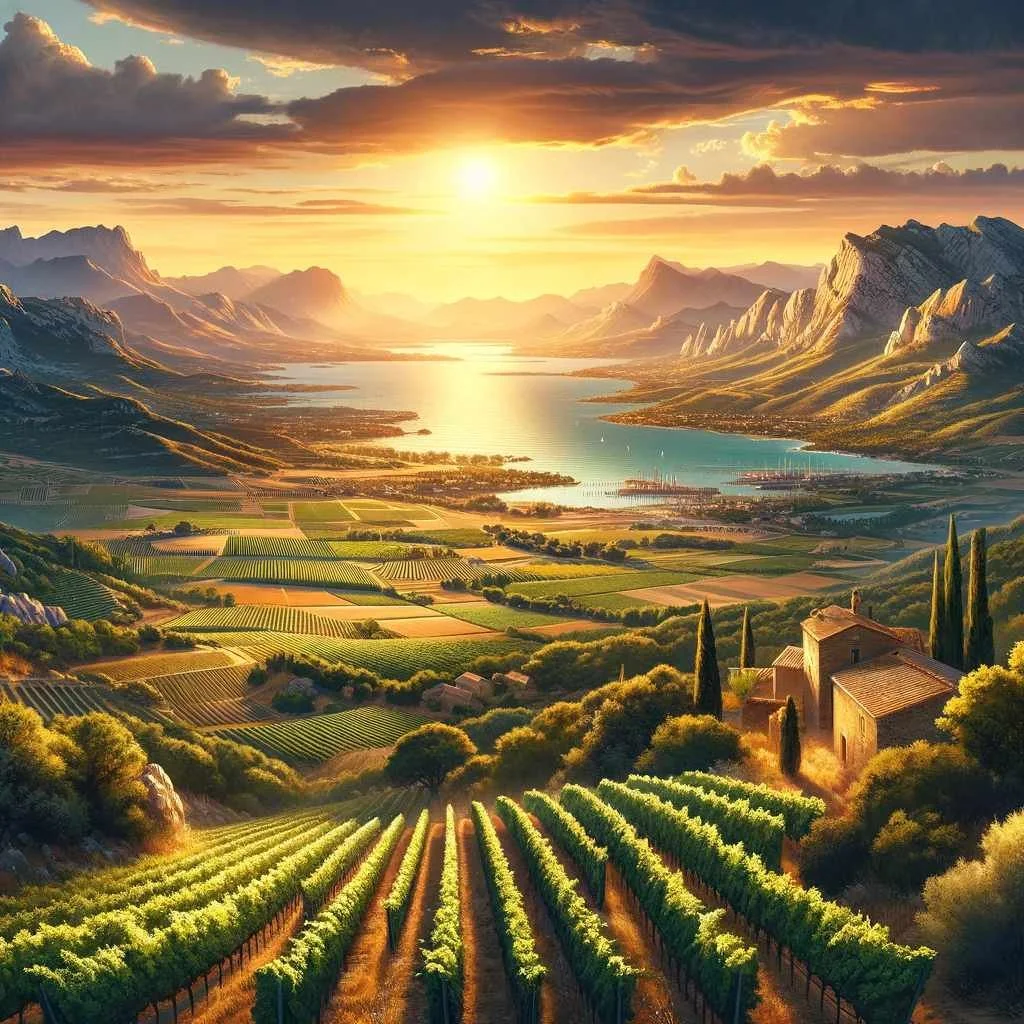
French Wine Regions
-
France is renowned globally for its wine, boasting some of the most famous wine regions, grape varieties, and historic vineyards. French wines are celebrated for their diversity, quality, and the depth of the country's winemaking heritage.
-
Key Wine Regions of France:
Bordeaux: Famous for its red blend wines, primarily Cabernet Sauvignon and Merlot. Bordeaux is divided into the Left Bank and Right Bank, each with its unique soil types and wine styles.
Burgundy (Bourgogne): Known for its Pinot Noir and Chardonnay wines, Burgundy is home to some of the most prestigious and expensive wines in the world, including those from the Côte d'Or.
Champagne: The only region in the world that can legally produce Champagne, the sparkling wine made from Chardonnay, Pinot Noir, and Pinot Meunier.
Rhône Valley: Produces a variety of wines but is particularly known for its Syrah (northern Rhône) and Grenache-based blends (southern Rhône).
Loire Valley: Offers a wide range of wines, from the light, crisp Sauvignon Blanc of Sancerre to the medium-bodied reds of Chinon (Cabernet Franc).
Alsace: Unique for its Germanic influence, Alsace is known for aromatic white wines like Riesling, Gewurztraminer, and Pinot Gris.
AOPs (Appellations of Origin Protections)
France's appellation system, Appellation d'Origine Protégée (AOP), formerly known as Appellation d'Origine Contrôlée (AOC), is a regulatory mark that guarantees the geographical origin of a wine and adherence to specific production methods:
AOP (Appellation d'Origine Protégée): Ensures wines are produced in defined areas, using grape varieties and winemaking practices established by the appellation's rules.
Vin de Pays (IGP - Indication Géographique Protégée): A category that allows for more varietal flexibility and innovation, often regionally focused.
Vin de France: The most flexible classification, focusing less on geographical origin and more on the grape variety.
-
French wines are deeply influenced by the concept of terroir, the unique combination of geography, geology, climate, and winemaking tradition that gives each wine its distinctive character.
-
These varieties illustrate the vast palette from which French winemakers draw to create a wide array of wine styles, from the structured elegance of Bordeaux and Burgundy to the aromatic complexity of Alsace and the freshness of the Loire Valley. Each variety contributes its unique characteristics to the mosaic of French wine, underscoring the country's unparalleled diversity in winemaking.
Chardonnay: Versatile and widely planted, Burgundy's white grape produces wines ranging from crisp and mineral to rich and buttery.
Sauvignon Blanc: Best known from the Loire Valley and Bordeaux, it delivers crisp, aromatic wines with high acidity.
Riesling: Grown in Alsace, known for its floral aromas and ability to express terroir.
Viognier: The key grape of Condrieu in the Rhône, offering perfumed aromas of peach and violets.
Chenin Blanc: Loire Valley's versatile grape, used to make everything from dry to sweet and sparkling wines.
Semillon: Often blended with Sauvignon Blanc in Bordeaux, especially in the sweet wines of Sauternes.
Gewurztraminer: Another Alsatian variety, producing highly aromatic wines with notes of lychee and spice.
Pinot Gris: Known as Pinot Grigio in Italy, Alsace's Pinot Gris produces rich, slightly sweet wines.
Muscadet (Melon de Bourgogne): Grown in the Loire Valley, producing light, crisp wines with mineral notes.
Ugni Blanc (Trebbiano): France's most planted white grape, primarily used in Cognac and Armagnac production.
-
French wines are celebrated for their diversity, largely due to the wide range of grape varieties cultivated across the country's many wine regions. Here are the top 20 French grape varieties, split between red and white, that contribute significantly to the richness of France's vinicultural heritage.
Cabernet Sauvignon: A key component in Bordeaux blends, known for its depth and complexity.
Merlot: Widely planted in Bordeaux, producing softer, more approachable wines than Cabernet Sauvignon.
Pinot Noir: The heart of Burgundy, yielding wines of great elegance and complexity.
Syrah: Dominant in the Rhône Valley, known for producing powerful, spicy wines.
Grenache: Often found in Southern Rhône blends, contributing richness and red fruit flavors.
Cabernet Franc: Particularly important in the Loire Valley, offering floral and lightly peppery notes.
Cinsault: Used in the blends of Southern France, adding softness and aroma.
Carignan: Known for its deep color and high tannins, adding structure to Southern French blends.
Gamay: The grape of Beaujolais, producing light, fruity wines with high acidity.
Mourvèdre (Monastrell): Adds complexity and structure to Rhône and Provence wines.
-
France's winemaking techniques vary widely across regions, from the traditional method of Champagne production to the whole-bunch fermentations of Beaujolais (Gamay). The emphasis is on expressing the terroir through meticulous vineyard management and winemaking practices.
-
Red Wines: Served at room temperature or slightly cooler, depending on the style.
White Wines and Champagne: Served chilled, to highlight their acidity and freshness.
Pairing French Wines with Food:
French wines are immensely diverse, making them versatile partners for a wide range of cuisines. From the rich, hearty dishes of Burgundy that pair beautifully with Pinot Noir, to the fresh seafood of the Loire Valley that complements its Sauvignon Blanc, the possibilities are endless.
-
The French wine classification system, including AOP and IGP, ensures that wines meet strict standards related to grape varieties, winemaking practices, and geographical origin.
-
Terroir: The set of all environmental factors that affect a crop's phenotype. The combination of soil, climate, topography, and local winemaking traditions that give a wine its unique character.
Millésime: The vintage year of the wine, indicating the year the grapes were harvested.
Cuvée: A blend or special lot of wine.
Appellation d'Origine Protégée (AOP): The European Union's system for regulating geographical indications, guaranteeing the origin and quality of traditional wines.
Vin de Pays (VDP): Now referred to as IGP (Indication Géographique Protégée), it denotes wines of good quality from specific regions.
Cru: A vineyard or group of vineyards, especially one of recognized quality.
Premier Cru: A classification step below Grand Cru, used in Burgundy and Champagne to indicate a high-quality vineyard.
Grand Cru: A classification denoting a vineyard known for its excellent terroir and high-quality wines, especially in Burgundy and Alsace.
Château: Often used in Bordeaux, it refers to a wine estate with its own vineyard.
Domaine: Common in Burgundy, it denotes an estate that produces and bottles wine from its own vineyards.
Cuvée: Refers to a specific blend or batch of wine, often used to denote a particular style or quality.
Vieilles Vignes: Means "old vines," suggesting that the wine is made from grapevines that are typically over 40 years old, producing more concentrated flavors.
Sur Lie: Wine aged "on the lees" (dead yeast cells), which can add complexity and texture.
Élevage: The process of aging wine, often in barrels, before bottling.
Dégorgement: The process of removing sediment from traditionally made sparkling wines, such as Champagne.
Assemblage: The art of blending different wines to achieve the final product, especially important in Champagne production.
En Primeur: A method of purchasing wines early while they are still in the barrel, particularly common in Bordeaux.
Remontage: The process of pumping wine from the bottom of the fermentation tank over the cap of grape skins to enhance color and flavor extraction.
Bâtonnage: Stirring the lees in a barrel or tank to add richness and complexity to the wine.
Rosé de Saignée: A method of rosé production that involves bleeding off juice from red wine fermentations.
Cru Classé: A classification of wine estates, particularly in Bordeaux, under the 1855 Bordeaux Wine Official Classification.
Liqueur de Tirage: A mixture of sugar and yeast added to still wine to start the second fermentation in making traditional method sparkling wines, like Champagne.
These terms reflect the complexity and tradition of French winemaking, showcasing the depth of knowledge that goes into producing some of the world's most revered wines.
-
Websites:
Decanter: Offers extensive coverage on French wines, including regional guides, producer profiles, and wine reviews. Decanter
The Wine Society: Provides detailed information on French wine regions, grape varieties, and producers, along with offering a wide selection of wines. The Wine Society
Wine-Searcher: Useful for researching French wines, comparing prices, and reading about different regions and grape varieties. Wine-Searcher
Jancis Robinson: The website of renowned wine critic Jancis Robinson features articles, wine reviews, and a comprehensive wine glossary with a focus on French wines. Jancis Robinson
Vinous: Offers detailed tasting notes, wine scores, and in-depth articles about French wine regions and producers. Vinous
Books:
"The Wines of France: The Essential Guide for Savvy Shoppers" by Jacqueline Friedrich: This book provides an accessible introduction to French wines, focusing on how to select and enjoy them.
"The Oxford Companion to Wine" by Jancis Robinson: A comprehensive wine reference book with extensive information on French wine regions, grape varieties, and winemaking practices.
"The World Atlas of Wine" by Hugh Johnson and Jancis Robinson: Features detailed maps and insightful information on all major French wine regions, making it an invaluable resource for understanding the geography of French wine.
"French Wine: A History" by Rod Phillips: Offers a deep dive into the history of wine in France, exploring how the country became a benchmark for quality wine production.
"Wine Folly: The Master Guide" by Madeline Puckette and Justin Hammack: While not solely focused on French wine, this visual guide includes helpful infographics and information on France's key wine regions and grape varieties.
These resources combine to offer a well-rounded understanding of French wines, from the basics of wine appreciation to the complexities of France's diverse wine regions. Whether you're a casual enthusiast eager to learn more about your favorite French wines or a serious student of viticulture, these books and websites provide valuable insights into the heart of French winemaking.
-
In France, the major wine regions are often associated with smaller towns and villages that are central to the wine industry. However, larger cities near these regions can serve as gateways for exploring the surrounding vineyards. Here’s an overview of significant cities related to the key wine regions of France:
Bordeaux
Bordeaux: The city itself is the heart of the wine region, serving as a commercial and cultural hub for the wine industry.
Burgundy (Bourgogne)
Dijon: The capital of the Burgundy region, Dijon is close to several key wine-producing areas, including the Côte d'Or.
Beaune: Often considered the wine capital of Burgundy, Beaune is central to the region's winemaking and wine trade.
Champagne
Reims and Épernay: Both cities are central to the Champagne industry, with many of the most famous Champagne houses based in these areas.
Rhône Valley
Lyon: While not within the Rhône wine region itself, Lyon is close to the northern Rhône and is a significant cultural center for the region's wines.
Avignon: Located near the southern Rhône, it's a historical city with close ties to the wine industry.
Loire Valley
Tours and Nantes: Tours is near the middle Loire wine regions, while Nantes is associated with the Muscadet area near the Loire's mouth.
Alsace
Strasbourg: The capital city of the Alsace region, Strasbourg is near the northern part of the Alsace wine route.
Provence
Marseille: As the largest city in the Provence region, Marseille is a starting point for exploring the Côtes de Provence and other nearby wine areas.
Languedoc-Roussillon
Montpellier: A major city close to several Languedoc wine-producing areas, serving as an economic and cultural center for the region.
Beaujolais
Lyon: Again, Lyon is the nearest large city to the Beaujolais region, providing access to this unique wine-producing area.
These cities are pivotal for their proximity to or involvement in their respective wine regions, offering access to vineyards, wine tours, and tastings. The combination of historical significance and modern amenities makes them excellent bases for exploring the rich tapestry of French wine culture.










